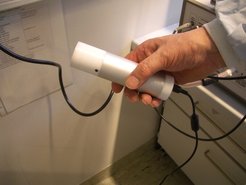Cold Plasma eliminates Ehec bacteria
In first experiments with prototypes the number of these dangerous germs is reduced drastically

The researchers at the Max Planck Institute for Extraterrestrial Physics (MPE) and the "Klinikum Schwabing" reduced more than 100 cultures of five different Ehec strains drastically. All strains are E.coli bacteria with the serotype O104:H4 producing the Shiga toxin, which were isolated during the present Ehec wave from patients with the HUS-syndrome. At the microbiology department of the hospital in Schwabing, the scientists treated the germ cultures with two prototypes producing a cold plasma, which were developed at the MPE. "The results are very convincing from our perspective," says Gregor Morfill, director at the MPE, who led the study. "Even though the Ehec bacteria are somewhat more robust than normal E.coli bacteria this did not matter for their inactivation."
One of the devices, which can be extended in a modular fashion, could be expanded to a large facility with some further development. Companies processing foodstuffs could use these facilities to eliminate Ehec bacteria already during production. In the current experiments, the prototype device reduced the number of germs in 15 seconds by a factor of 10 000 - enough to ensure that fruit and vegetables can be consumed without any concerns. The other device could be used by consumers to kill germs in their own kitchen. With a similar size to a flashlight it could be produced to about 100 Euros. In the experiments, this device reduced the germs in 20 seconds by a factor of 100 000. "These prototypes just need to be brought to maturity for industry," says Gregor Morfill.
Plasmas are already used in medicine today, e.g. to sterilise chirurgical instruments, but most of these plasmas are hot. Fresh produce cannot be treated in this way. The scientists at the MPE, however, produce plasmas which are lukewarm. The physicists at the MPE use these kinds of plasma to study how crystals form and how liquids flow - some experiments are even on the International Space Station. "As our plasmas are cold, they lend themselves naturally to a medical application," says Gregor Morfill. In a currently ongoing clinical trial, the researchers test how chronically infected wounds can be treated with cold plasma or how the hospital staff could use it to disinfect their hands. First results indicate better and faster healing and the new experiments now show that devices with cold plasma could also contribute to improve hygiene when dealing with foodstuffs.
When treating food with plasma, does this affect the food's taste? Naturally there can be no comprehensive answer to this question - all relevant foodstuffs would need to be tested. In general, however, a number of studies show that cold plasmas do not cause substantial surface modifications (in particular on heat-sensitive surface such as the human skin even with a plasma dose that is 100 times larger). Presumably the cold plasma therefore should cause neither a change in taste nor in nutrients. Plasma only modifies the air "homoeopathically" for a short time, then everything recombines "ecologically" without any residues.
